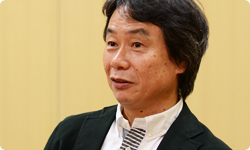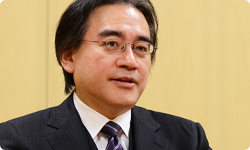A product like this is something we’d never be able to release without a strong partnership with the Louvre.
That’s true.
And because we were able to release this in a way that people will be able to enjoy on their own, it now has all kinds of different value for different people, whether they have been to the Louvre, are going to the Louvre, or don’t have plans to go but are interested in it. And it could even have different meaning for the same person, depending on their knowledge at that time or situation.
I think it’s quite an experimental product. Personally, I would love to see people using it as an educational tool in art classes. I think it would get students really interested as they use the software to watch and listen.
It does make you want to go see the real thing.
You can experience it just by pressing buttons and looking at different things that strikes a hint of your curiosity. It’s fun to be able to learn new things like that. It has a good search feature too, so you can check each work and each place, or choose a recommended course. If you put it into automatic mode, you can experience an actual tour as if you’re there.
And then if they go to the museum one day, I’m sure it will change how they see it all. I feel like it can create that kind of a wondrous experience.
We really would like people to try it out.
In a broad sense, I think that this is all linked to the experiments with Ikspiari. It’s something that you’ve worked on for five or six years.
That’s very true.
There are a lot of projects you spend several years on. As far as I know, the longest was the Mii24 concept. You were even saying, “Next is avatars” back when we were working on the Family Computer Disk System.2524. Mii: Avatars users create to act as player characters on the Nintendo 3DS, Wii and Wii U systems.25. Family Computer Disk System: A peripheral product for the Family Computer system (Famicom) released in February 1986 in Japan. For media, the system used floppy disks on which software could be written. The Famicom system was released as the Nintendo Entertainment System (NES) in North America and Europe.
If you start there, it’s been almost 30 years.
The Disk System came out in 1986, so it’s been 27 years. (laughs) That’s a bit unusually long, to be honest. But well, you do have quite a lot of other things you’ve been working on for five years, including some things we can’t talk about yet.
When I said, “From here on, I’ll be involved in smaller projects” during an overseas interview last year, it was somehow reported that I was retiring, but this software must have been one of the projects in my mind when I made that remark back then.
Yes, that did happen. Well, I certainly wouldn’t call this a small project! (laughs)
Usually I don’t even know which it will be. It’s only after I get results that I realise, “Oh, this was it.”

We don’t always have a picture of the final finished product at the very beginning. It’s like things that were said as an ideal, or fantasy ideas that are linked together.
Back when I said, “One day, the Louvre!” I never thought that it would happen like this. But our goal hasn’t changed since the very beginning.
I feel like what I was able to do was to give you the encouragement to go down the path when you found something you knew would be interesting, while cleaning up anything in your way and convincing people to support you.
I suppose so. Thank you very much.
Now then, for my last question. As we’ve been talking together today, I’ve been thinking again about just why your ambition became a reality. And I think it was really the culmination of a lot of small things, both successes and failures.We learned a lot from the test with Ikspiari, and the collaborations with various facilities, both small and large. And then the Nintendo 3DS system came along, and we were able to work with the Louvre Museum whom we were able to get in touch with at the perfect time, and that’s how we managed to make this all happen.

It was partially about timing. The Louvre people wanted to do a guide on the Nintendo 3DS system because there was this idea of working with 3D photos and 3D models. If we’d had this same discussion when we only had Nintendo DS, they wouldn’t have agreed to it. So we were lucky.
So it wasn’t just a vague dream – we were doing all kinds of things, and in the end, we were prepared for it. It wasn’t that we knew what was going to happen, just that we got this chance when we were ready for it. One of my favourite sayings is, “Luck is the meeting of preparation and opportunity.” We were so lucky to be able to make the most of this wondrous connection.
That’s quite true.
We really want everyone to be able to experience the Louvre Museum from their own home. And if you ever have the chance to go to the Louvre, bring this software with you. I think it will enrich your experience there.
By the way, let me say one thing that would be fun for Miiverse26. There’s a single photo of you somewhere in the software, isn’t there, Miyamoto-san?
26. Miiverse: A network service, integrated with Wii U at the system level, that allows people all over the world to connect through their Mii characters and more fully enjoy video games. People can interact by sharing their thoughts in the communities of their favourite games and by posting handwritten illustrations and comments. The service will be available on Nintendo 3DS systems in December 2013.
Yeah, someone put that in without letting me know. I didn’t have it taken out, so it shipped out with it in there. I hope everyone looks for it and finds it.
We’re also selling a special packaged version at the museum gift shops too, and it would make a wonderful souvenir.
Of course. Thank you very much.
© 2024 Nintendo.